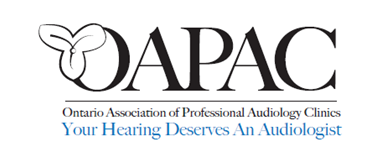YOU DESERVE TO BE HEARD
ADVOCATING FOR
ONTARIO’S AUDIOLOGISTS
ONTARIO’S AUDIOLOGISTS
Speaking up for professional Audiology clinics!
Advocacy
OAPAC is committed to ongoing advocacy work on behalf of its members and the Audiology profession. This advocacy includes working with key political stakeholders in the provincial government to advance the goals of OAPAC and protect the health and well-being of Ontarians. OAPAC has spent over three decades trying to effectuate changes that would save the government money while preserving and improving quality of hearing care for Ontarians, and continues to do so diligently.
and the Audiology profession. This advocacy includes working with key political stakeholders in the provincial government to advance the goals of OAPAC and protect the health and well-being of Ontarians. OAPAC has spent over three decades trying to effectuate changes that would save the government money while preserving and improving quality of hearing care for Ontarians, and continues to do so diligently.
All of our advocacy work is conducted in line with our organizational mission: to grow, expand and foster Audiologist-owned clinics across Ontario, offering local, safe, regulated services for hearing and balance.
Currently, OAPAC is focused on fostering change in two key areas. We are recommending that the Ontario Government:
- Remove the ‘double signature’ requirement when the Audiologist is the prescriber.
- Issue ID Practitioner Numbers to Audiologists to allow Audiologists to refer patients directly to ENT Surgeons when medically necessary.
Removing the Double Signature Requirement on Applications for Assistive Devices
Background:
The Assistive Devices Program (ADP) was established through policy in 1982, to provide support and funding for Ontarians with permanent disabilities. Audiologist clinic owners applied and were issued Vendor permits to dispense hearing aids. Prescribing a hearing aid became a controlled act under the Regulated Health Professions Act, 1991. Only registered Audiologists were issued the license act while physicians were grandfathered in.
In 1994, twelve years after ADP, the College of Audiologists and Speech-Language Pathologists of Ontario (CASPLO) was founded. In adherence with CASLPO’s strict guidelines for assessment, Audiologists are responsible for hearing aid assessment, verification, and validation follow-up, as well as the controlled act of hearing aid prescription. As prescribers and authorizers of hearing aids, they also act as signatories on forms requesting Assistive Devices.
Currently, in order for the request for an Assistive Device to be submitted, the patient’s family physician must also sign the ADP form along with the Audiologist. There is no medical value added by a physician’s involvement nor are there any legal requirements when the prescriber is an Audiologist.
Audiologists are accountable to CASLPO, and therefore, Audiologist practitioners should practice independently, without the supervision of other medical professionals who were not governed by, or accountable to the body that regulates the practice of Audiology.
The double signature requirement represents an additional cost to OHIP and is redundant when an Audiologist is the prescriber. The requirement also potentially increases wait times to see a family physician and decreases the percentage of people who are able to access same day and next day appointments in all primary care settings.
The second signature should therefore be removed when the Audiologist is the prescriber.
Benefits:
This recommendation is a simple fix and represents a mutually beneficial solution for both Audiologists across Ontario and the Ontario Government.
This change is purely administrative that will reduce significant costs to OHIP, saving approximately $7 million dollars annually (conservative estimate calculated by OAPAC) while simultaneously increasing the capacity of healthcare delivery.
This change would also improve patient access to primary care physicians and alleviate delays in access to critical care, ensuring more positive outcomes for Ontarians with hearing loss. Seniors, who are among the most vulnerable populations in Ontario, will no longer face the barriers of the cumbersome process required to receive a hearing aid, resulting in increased adoption or acceptance of them. This too could reduce other significant health risks such as COVID or Influenza, which can be fatal in some cases.
Treating hearing loss quickly and proactively can potentially mitigate the progression of dementia and other medical conditions thereby reducing additional burdens on the healthcare system in the future as well.
Third Party Insurers such as Desjardins Insurance and Green Shield Canada, as well as WISB accredit the Audiologist’s licensed act to prescribe a hearing aid for a hearing impaired person and recognize the Audiologist’s scope of practice to dispense the devices. ADP should be doing the same.
Issue ID Practitioner Numbers to Audiologists to allow Audiologists to refer patients directly to ENT Surgeons when medically necessary.
Background:
Audiologists are qualified and well-positioned to directly refer patients to otolaryngologist (ENTs).
ENTs, or otolaryngologists, are physicians and surgeons who specialize in treating the interrelated systems of the ears, nose, sinuses, and throat. Audiologists and ENTs often work closely together to complete care. When a patient’s hearing loss has an organic or physical cause, for example, the Audiologist may recommend seeing an ENT for corrective treatment.
In order to do so, however, a patient must first receive a referral from a family physician.
This requirement for a referral from a family physician poses several problems. While referrals from non-physicians might be permitted by the Specialist, according to OHIP rules, when a non-physician practitioner requests the opinion of a physician or requests the transfer of care of a patient to a physician, the service provided by the physician in such circumstances cannot be claimed to OHIP as a consultation (OHIP Bulletin 4318, page 2). The service claimed must therefore be a lower assessment fee — specialists are thus compensated for less, which acts as a deterrence.
Referral to a family physician unnecessarily wastes OHIP dollars. This process requires OHIP to be billed three separate times:
- When the patient sees their Audiologist.
- When the patient sees their family physician.
- When the patient sees their ENT.
The process ties up the time of additional health professionals, unnecessarily increasing wait times to see a family physician. Some patients seen by Audiologists lack a family doctor physician altogether and therefore cannot be referred to an ENT if needed, creating a clear barrier to critical care. (2 million people lack a family physician.)
The solution to these problems is clear: facilitate Audiologists to directly refer patients to ENTs by issuing a referral number.
This practice is already in place in Alberta and the benefits of its implementation are evident.
Benefits:
Direct referral enables the Audiologist to see the patient directly, triage that patient, and refer to the ENT only as needed. This reduces the number of OHIP billing instances and ensures patients receive quick and effective Audiological treatment. In fact, a one-year study of patients with hearing problems, found that 95% of patients only required Audiological treatment, foregoing the need for an additional reference to an ENT. This is supported by many other studies, such as one featured in the Journal of the American Academy of Audiology, 21(6), 2010.
Direct referral to an ENT will provide significant cost savings to OHIP by limiting unnecessary billing instances. Literally millions of dollars could be saved annually.
Issuing ID Practitioner Numbers to Audiologists will allow Audiologists to refer patients directly to ENT Surgeons when medically necessary, saving Ontario valuable dollars and Ontarians lengthy wait-times for critical care.

